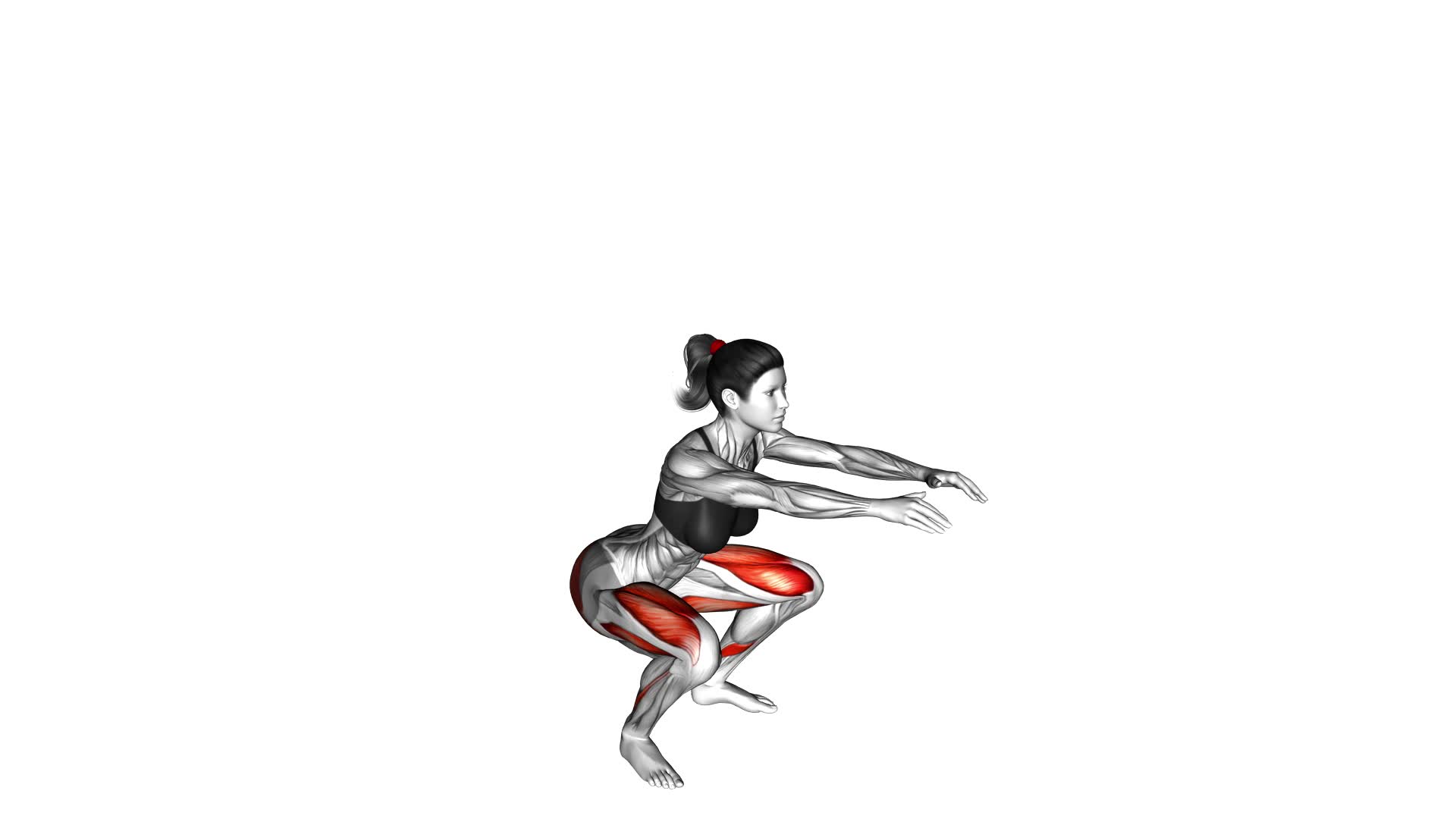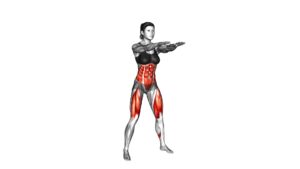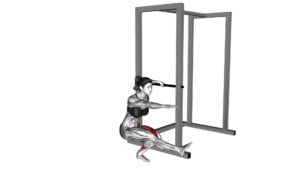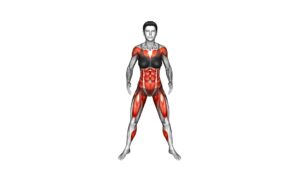Squat (female) – Video Exercise Guide & Tips

Are you looking to tone your lower body and strengthen your muscles? Look no further! This article provides a comprehensive guide on squats specifically designed for women.
Watch This Exercise Video
Learn the proper technique, variations for different fitness levels, and common mistakes to avoid.
Discover tips to increase the intensity of your squat workouts and find out how to incorporate them into your fitness routine.
Get ready to feel the burn and see incredible results with this video exercise guide and tips.
Key Takeaways
- Squats target multiple muscle groups simultaneously, including the glutes, quadriceps, hamstrings, and calves.
- Squats can increase overall muscle mass and boost metabolism.
- Proper squat technique and form, such as maintaining a neutral spine position and aligning knees with toes, are important to prevent strain on knees and lower back.
- Squats can be modified and varied to target specific areas, accommodate different fitness levels, and add variety to workouts.
Benefits of Squats for Women
If you're a woman, incorporating squats into your workout routine can offer a multitude of benefits. Squats aren't only a great way to strengthen and tone your lower body, but they also provide several other advantages for women.
One of the main benefits of squats is that they target multiple muscle groups simultaneously, including your glutes, quadriceps, hamstrings, and calves. By engaging these large muscle groups, squats help to increase overall muscle mass, which in turn can boost your metabolism and aid in weight loss.
Another benefit of squats for women is improved core strength and stability. When you perform squats, your core muscles, including your abdominals and lower back muscles, are activated to maintain proper form and balance. This not only helps to develop a strong and stable core, but it also enhances your overall functional fitness and reduces the risk of injury during other exercises or daily activities.
Additionally, squats can be modified and varied to target specific areas or address individual goals. Some popular variations of squats for women include sumo squats, squat jumps, and pistol squats. Sumo squats target the inner thighs, while squat jumps add a cardiovascular element to your workout. Pistol squats, on the other hand, focus on balance and stability, as they're performed on one leg.
In order to reap the full benefits of squats, it's important to ensure proper squat technique and form. By maintaining good posture, keeping your knees aligned with your toes, and engaging your core muscles, you can maximize the effectiveness and safety of your squatting routine. Proper form also helps to prevent strain on your knees and lower back.
Proper Squat Technique and Form
To perform squats with proper technique and form, you should focus on maintaining a neutral spine position throughout the movement. This means keeping your back straight and aligned from your head to your tailbone. Avoid rounding or arching your back, as this can lead to injury.
Additionally, it's important to pay attention to your knee alignment during squats. Make sure your knees are tracking in line with your toes and not collapsing inward or splaying outward. This helps to protect your knees and ensures proper muscle activation.
Another key aspect of proper squat technique is hip mobility. You should aim to achieve a full range of motion in your hips, allowing you to lower your body down into a deep squat position. This requires adequate flexibility in your hip flexors, glutes, and hamstrings. If you struggle with hip mobility, you can incorporate exercises like hip stretches and mobility drills into your warm-up routine.
Remember to start with a weight that's appropriate for your fitness level and gradually increase the load as you become stronger and more comfortable with the movement. Proper technique and form are crucial for maximizing the benefits of squats and reducing the risk of injury. By focusing on maintaining a neutral spine position, proper knee alignment, and improving hip mobility, you can perform squats safely and effectively.
Variations and Modifications for Different Fitness Levels
As you progress in your fitness journey, you can explore different variations and modifications of squats to cater to your specific fitness level and goals. These variations not only add variety to your workouts but also target different muscles and provide new challenges.
Here are three variations and modifications of squats that you can try:
- Modifications for injuries: If you have knee or back injuries, you can modify squats to reduce the strain on these areas. One option is to perform box squats, where you squat down onto a box or bench, reducing the depth of the squat. Another modification is to use a resistance band around your thighs to provide support and stability.
- Squatting with weights: Once you have mastered the basic squat, you can add weights to increase the intensity of the exercise. This can be done by holding dumbbells or a barbell on your shoulders or in front of your body. Squatting with weights challenges your muscles and helps to build strength and power.
- Pistol squats: Pistol squats are a more advanced variation that require significant balance, flexibility, and strength. In this variation, you squat down on one leg while extending the other leg straight out in front of you. Pistol squats engage your core, glutes, and quads more intensely than regular squats.
Remember to always listen to your body and choose variations that are suitable for your fitness level and any existing injuries.
Common Mistakes to Avoid During Squats
When it comes to squats, there are a few common mistakes that you should avoid. One mistake is letting your knees cave inwards during the movement, which can put unnecessary strain on your joints.
Another mistake is performing shallow depth squats, where you don't lower your body enough to engage the muscles properly.
Lastly, incorrect foot positioning can affect your balance and stability during the exercise.
Knees Caving in
Avoid letting your knees cave inwards during squats by focusing on keeping them aligned with your toes. Proper knee alignment is crucial for preventing injuries and maximizing the benefits of squats. Here are three tips to help you maintain proper knee alignment:
- Engage your glutes: Strong glutes are essential for hip stability and proper knee alignment. Prioritize exercises that target your glutes, such as hip thrusts and glute bridges, to improve hip mobility and control during squats.
- Activate your core: A strong core provides a stable base for your hips and knees. Engage your core muscles by drawing your belly button towards your spine during squats. This will help maintain proper alignment and prevent your knees from collapsing inward.
- Focus on form: Pay attention to your squat technique. Keep your weight centered over your heels, push your knees outwards, and avoid excessive forward lean. By maintaining proper form, you can ensure that your knees stay aligned with your toes throughout the squat movement.
Shallow Depth Squats
Are you struggling to reach proper depth in your squats?
One common mistake that people make during squats is performing shallow depth squats.
While it may be tempting to only go down partially, it's important to understand the benefits of deep squats.
Deep squats engage a larger range of motion, which helps to strengthen your lower body muscles, including the glutes, quadriceps, and hamstrings.
By going deeper into your squats, you also activate your core muscles, promoting better stability and balance.
In addition, deep squats improve flexibility in the hips and ankles, allowing for better overall movement and reducing the risk of injury.
Incorrect Foot Positioning
To optimize your squat form, prioritize proper foot positioning for optimal results. Improper alignment and foot placement errors can hinder your progress and increase the risk of injury. Here are three common mistakes to avoid during squats:
- Placing your feet too close together: This can cause instability and compromise your balance, making it harder to maintain proper form throughout the movement.
- Allowing your knees to cave inward: This can put excessive stress on your knee joints and lead to pain or injury. Make sure to keep your knees aligned with your toes throughout the entire squat.
- Pointing your toes too far outward: While a slight outward angle is normal, excessively turning your toes outward can strain your knees and make it harder to engage your glutes and hamstrings.
Tips to Increase the Intensity of Squat Workouts
To increase the intensity of your squat workouts, try incorporating resistance bands or weights into your routine. By adding external resistance, such as resistance bands or dumbbells, you can challenge your muscles and make your squat workouts more effective.
Resistance bands are especially useful as they provide constant tension throughout the movement, targeting your muscles in different ways and increasing squat resistance. You can attach resistance bands around your thighs or loop them under your feet to add resistance while performing squats. This will engage your glutes, quads, and hamstrings even more.
Another way to increase the intensity of your squat workouts is by performing dynamic squat exercises. These exercises involve adding explosive movements to your squats, such as jump squats or squat jumps. These movements increase the speed and power of your squat, engaging more muscle fibers and increasing the overall intensity of the exercise.
Incorporating dynamic squat exercises into your routine can also help improve your athletic performance and enhance your explosive strength.
Remember to start with a weight or resistance level that challenges you but still allows you to maintain proper form. Gradually increase the resistance or weight as you get stronger and more comfortable with the exercises. Always prioritize proper form and alignment to prevent injuries and maximize the effectiveness of your squat workouts.
Incorporating Squats Into Your Fitness Routine
Are you looking to add squats to your fitness routine? Incorporating squats into your workouts can offer numerous benefits for your overall fitness and strength.
Not only do squats target multiple muscle groups, but they also help improve your balance, stability, and mobility. With various squat variations available, you can easily modify your routine to keep challenging yourself and prevent boredom.
Remember to maintain proper squat form to maximize the effectiveness of your workouts and minimize the risk of injury.
Benefits of Squats
Incorporating squats into your fitness routine offers many benefits. They are a versatile exercise that targets multiple muscle groups and can be done with or without weights. Here are three key benefits of incorporating squats into your workout:
Improved lower body strength: Squats primarily work your quadriceps, hamstrings, and glutes, helping to build strength and power in your legs. Stronger leg muscles can enhance your performance in various activities and sports.
Increased core stability: Squats engage your core muscles, including your abs and lower back, to maintain proper form and balance. This not only strengthens your core but also helps improve your overall stability and posture.
Calorie burning and weight loss: Squats are a compound exercise that engages multiple muscle groups simultaneously, leading to higher calorie expenditure. Incorporating squats into your fitness routine can help accelerate your weight loss goals.
Remember to maintain proper squat technique by keeping your chest up, knees aligned with your toes, and lowering your hips back and down as if sitting into a chair. Start with bodyweight squats and gradually add weights for greater intensity.
Variations of Squats
Try incorporating different variations of squats into your fitness routine to target different muscle groups and keep your workouts challenging. Squat variations can help you work different areas of your lower body, including your glutes, quads, hamstrings, and calves. One popular variation is the sumo squat, where you take a wider stance and turn your toes outwards to target your inner thighs.
Another variation is the jump squat, which adds an explosive element to your workout and helps improve power and explosiveness. Other squat modifications include the Bulgarian split squat, which emphasizes single-leg strength, and the pistol squat, which requires balance and stability. By incorporating these squat variations into your routine, you can maximize your leg and glute gains and prevent plateaus in your training.
Now, let's move on to discussing the proper squat form.
Proper Squat Form
To effectively incorporate squats into your fitness routine, master the proper form by squatting down and standing up while keeping your back straight and engaging your core. This will ensure that you maximize the benefits of squats and reduce the risk of injury.
Here are three tips to help you maintain proper squat form:
- Keep your weight on your heels: This will help activate your glutes and hamstrings, making your squats more effective.
- Maintain a neutral spine: Avoid rounding or arching your back during the movement. Keep your chest lifted and your shoulders pulled back.
- Modify as needed: If you're a beginner or have any physical limitations, try using a chair or stability ball for support. You can also adjust the depth of your squat to a comfortable range.
Frequently Asked Questions
Can Squats Help Me Achieve a Bigger Butt?
Squats are a great exercise for achieving a bigger butt. By targeting the gluteal muscles, squats can help to strengthen and tone your backside.
There are various squat variations that can provide even better results, such as sumo squats, Bulgarian split squats, and goblet squats. These variations engage different muscle groups and add variety to your workout routine.
Can Squats Help With Cellulite Reduction?
Squats are a great exercise for overall lower body strength and toning. They can help with cellulite reduction by targeting the muscles in your thighs and buttocks.
By incorporating different squat variations and maintaining proper squat form, you can maximize the benefits. Remember to engage your core, keep your chest lifted, and push through your heels.
Consistency and proper form are key to seeing results and reducing cellulite.
Can Squats Help Improve My Balance?
Squats can be a great exercise to improve your balance. By engaging your core and lower body muscles, squats help to strengthen your stabilizing muscles, which are crucial for maintaining balance.
Additionally, squats can also improve your posture by targeting the muscles that support your spine. So, incorporating squats into your workout routine can't only help you improve your balance but also increase your core strength and promote better posture.
Can Squats Cause Knee Pain?
Squats are a great exercise for improving knee health. However, they can also cause knee pain if done incorrectly. It's important to maintain proper form to prevent injury. Common mistakes in squat form include letting your knees cave in or going too low. By keeping your knees in line with your toes and not going too deep, you can protect your knees and get the most out of your squats.
Can Squats Help With Weight Loss?
Squats are a great exercise for weight loss. They work multiple muscle groups and can help you burn calories and build lean muscle. By incorporating squat variations and practicing proper squat form, you can maximize your results.
Squats engage your lower body, including your glutes, quads, and hamstrings, and can also improve your core strength. Remember to start with lighter weights and gradually increase as you build strength.
Squats are an effective addition to any weight loss routine.
Conclusion
Incorporating squats into your fitness routine can be highly beneficial for women. By practicing proper technique and form, you can strengthen your lower body muscles and improve overall strength and stability.
With variations and modifications available, squats can be tailored to different fitness levels. Avoiding common mistakes and increasing the intensity of your workouts can further maximize results.
So start adding squats to your routine and enjoy the benefits they bring to your fitness journey.

Author
Years ago, the spark of my life’s passion ignited in my mind the moment I stepped into the local gym for the first time. The inaugural bead of perspiration, the initial endeavor, the very first surge of endorphins, and a sense of pride that washed over me post-workout marked the beginning of my deep-seated interest in strength sports, fitness, and sports nutrition. This very curiosity blossomed rapidly into a profound fascination, propelling me to earn a Master’s degree in Physical Education from the Academy of Physical Education in Krakow, followed by a Sports Manager diploma from the Jagiellonian University. My journey of growth led me to gain more specialized qualifications, such as being a certified personal trainer with a focus on sports dietetics, a lifeguard, and an instructor for wellness and corrective gymnastics. Theoretical knowledge paired seamlessly with practical experience, reinforcing my belief that the transformation of individuals under my guidance was also a reflection of my personal growth. This belief holds true even today. Each day, I strive to push the boundaries and explore new realms. These realms gently elevate me to greater heights. The unique combination of passion for my field and the continuous quest for growth fuels my drive to break new ground.



